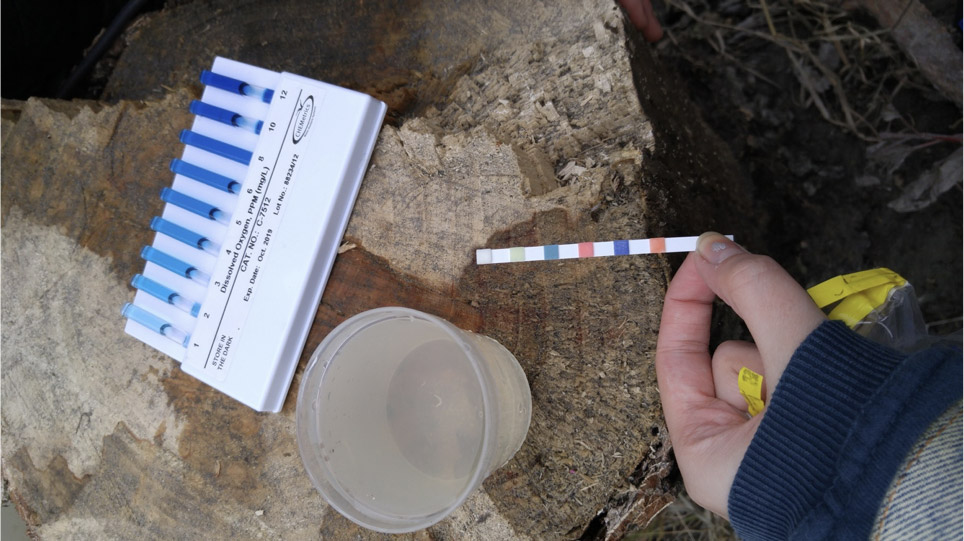Water Rangers vs. Professional probes
What the results say…
According to researchers at Carleton University, our testkits can be used to take accurate measurements of pH, temperature, conductivity and dissolved oxygen in water!
This post was written by Jose Atienza, Benson Chan, Steffani Guenette, Sofia Herczegh, Ashley LeBreton and Keith Pettinger in 2017. These Carleton University students are completing their studies in Environmental Sciences under supervisor Dr. Jesse Vermaire. This study is being adapted to be published as a whitepaper. You will notice that more than 20 samples were taken. Thank you to other testers who contributed additional data to this study, including Melissa Dakers from Watersheds Canada, Stéphanie Milot from Fédération des Lacs de Val-des-Monts, Katarina Furlanetto from Cataraqui Conservation Authority, and more samples using probes from Rideau Valley Conservation Authority and Mississippi Valley Conservation Authority.

Summary
In our world today, it’s very important to know the quality of our freshwater. Development and agriculture all over the world threaten Earth’s water resources. Scientists collect data for water quality monitoring to make sure water is safe for drinking and recreation as well as healthy for plants and animals to live in. It is not only scientists who play a role in keeping waterways clean, but citizens as well! Water Rangers is a non-profit organization that provides people with the tools to collect and share water quality data to learn more about the health of the lakes or rivers they care about. The Water Rangers test kits are an affordable, user-friendly, and accurate method of determining water quality that can be used by scientists as well as members of the public.
We conducted an experiment to see if the Water Rangers test kit was as accurate as a YSI probe that scientists commonly use to take field measurements of important water quality indicators such as pH, conductivity, temperature and dissolved oxygen. We sampled different water bodies in Ottawa and Gatineau with a test kit and YSI probe, then compared the results to evaluate how the Water Rangers test kit stacks up against professional equipment which costs thousands of dollars more.

We determined that the test kits were very accurate for measuring water quality and were comparable to the results we obtained from a YSI probe. This tells us that the Water Rangers Test Kits can be used for reliable data collection by citizen scientists.
Introduction
Monitoring water quality is very important for understanding changes in the health of lakes and rivers. Without monitoring data, it is impossible to say how much impact human activities have had on an aquatic ecosystem or if conservation projects are having a positive effect. If we don’t have regular monitoring data it is difficult to say whether the health of lakes and rivers is improving or potentially getting worse to the point where drinking, swimming, or even fishing in the water is becoming dangerous. Just like people should go to the doctor to track changes in their health, we need people tracking the health of lakes and rivers to ensure these valuable ecosystems remain healthy. Some of this work is done by government programs but these only monitor a very small number of the lakes and rivers out there, which is where citizen scientists can assist. Citizen science is an important part of the Water Rangers organization, by promoting community involvement in water health and recording data that helps people learn more about the health of their lake or river.
There are a few different types of test kits that the Water Rangers provide for the public to buy or rent, and our team used the Freshwater Explorer Kit, which costs $350. It measures the dissolved oxygen, conductivity, pH and temperature of water to determine its health and quality.

Dissolved Oxygen
Different freshwater species have various dissolved oxygen requirements: some need high levels and others need low levels of oxygen dissolved in their water habitats. However, without enough oxygen, many species like fish, frogs and insects might not be able to survive. When water becomes really polluted with nutrients, such as phosphorus, oxygen levels can drop to 0 creating dead zones in lakes where few animals can live.
Water Temperature
Water temperature also affects how aquatic organisms function, and can control the amount of oxygen that dissolves in water. Temperature can also change how organisms react to pollution, when they reproduce, and how they migrate, so it was important for us to also measure water temperature.
Conductivity
The Water Rangers Water test kit also measures conductivity, the ability of water to conduct an electrical current. Higher conductivity means there are more dissolved ions in the water, which is usually associated with more pollution.
pH
Lastly the kit also measures pH, which is very important because many freshwater species can only survive if the pH of their habitat is within a specific range, for example most fish live in water with pH between 6 and 9.
There are lots of tests that can be conducted to monitor water quality and if you’ve done any of them with the Water Rangers or another organization, you’re a citizen scientist! These data can be very helpful to citizen scientists and lake users who can use it to decide how healthy our freshwater habitats are.
Methods
As a team, we decided on 20 sites to sample freshwater across the Ottawa-Gatineau region. These data points were then combined with data obtained by scientists from nearby conservation authorities using the same methodology and included in our analyses.


We sampled water at each site from the upper layer around elbow deep (about 30 cm). Conductivity and water temperature were measured using the hand-held probe from the Water Rangers kit, and pH was measured by dipping the test strips in the water and matching their colour to the example colours on the container. Using the dissolved oxygen vials from the test kit we broke a vial within the sample of water, mixed the vial and compared its colour to the example shades of blue.
After we used the test kit for these four measurements we again measured temperature, dissolved oxygen, conductivity and pH with the YSI probe to compare.
Results
We used a computer program called R to analyze how close the results from the test kit matched to those from the YSI probe and graphed the relationship for all four parameters (temperature, pH, dissolved oxygen and conductivity). The closer the values are to a 45 degree line, the better the results.
Oxygen: very good
Our first graph shows how well the test kit measured dissolved oxygen compared to the YSI probe. You can see an equation with an R2 value, which is a way of showing how strong the relationship is, with 1.00 meaning that the test kit measured the same dissolved oxygen values as the YSI probe. The data points are quite close to their trend line and this shows that the water rangers test kit performed well when up against the YSI probe.
[visualizer id=”1462″]
The results for the comparison of dissolved oxygen in the water between the Water Rangers test kit and the YSI test probe were good. The R2 value from graphing the data is 0.8589, which means that they both gave very similar numbers. The closer the R2 value is to 1.00, the more similar the data between the test kits and the YSI are.
pH: okay
We graphed our pH results for both the test kit and the YSI probe, which had a lower R2 value of about 0.2, which means the test kit results showed different pH values when compared to the YSI metre. As a result, the data points are not as close to their trend line as for dissolved oxygen.
[visualizer id=”1463″]
The pH measurements differed between the two testing methods. The R2 value for the similarity between the test kit pH strips and the YSI probe was 0.2026, meaning they were not as similar as the dissolved oxygen, conductivity, or temperature. The Water Rangers test kits were still accurate at measuring pH, just not quite as accurate at the YSI probes.
[E.D. Kat Kavanagh’s note: We have chosen these test strips since they performed better than other strips (see this mini-study on test strip accuracy). However, many have said that they are sometimes hard to read, and so the human interpreting the readings change results. Over the next year, we will be testing new methods for collecting pH measurements, including inexpensive sensors that don’t require calibration and using cameras to help citizen scientists interpret the colour.]
Conductivity: excellent
This graph compares the conductivity values recorded from the test kit and the YSI probe, which had an excellent level of similarity and an R2 value of around 0.96. The data points collected are almost all along their trend line and this means that the test kit results are almost the same as those recorded from the YSI probe.
[visualizer id=”1459″]
Conductivity was very good! The R2 value was 0.9955, almost 1.00, which would mean a perfect match to the YSI. The conductivity meters in the test kit proved to be very accurate.
[E.D. Kat Kavanagh’s note: On top of this study, Chemist Conrad Gregoire has tested the short, medium and long term reproducibility of this meter’s accuracy over 50 days. Results show conductivity with a 99.2% accuracy rate (pdf).]
Temperature: excellent
The fourth parameter we graphed was water temperature, which had an R2 value of roughly 0.98 and data points that followed very closely to their trend line. Water Rangers test kit values were very close to the YSI probe values, with high similarity.
[visualizer id=”1461″]
Water temperature measured by the kits and the YSI probes were almost the same too. The R2 value was 0.9847. Temperature measured by the meter was very accurate and similar to the YSI numbers.
Conclusions
This study shows that the Water Rangers Testkits can be used to take accurate measurements of pH, temperature, conductivity and dissolved oxygen in water. The lowest measurement similarity between the test kit and the YSI probe was for pH, but with a difference of less than half a pH unit the test kit can still be used to indicate the difference between waters with high or low pH values. The dissolved oxygen values we recorded using the test kit were quite close to those recorded from the YSI probe, which means the test kit can be used to accurately measure water quality and monitor trends in freshwater ecosystems.
The Water Rangers test kits are affordable, easy to use and can be a tool in educating the public on water quality issues. A YSI probe requires calibration as well as user training; the test kits are an invaluable tool in water quality testing because they are comparable to a YSI for accuracy but are much more affordable and require minimal training. The Water Rangers test kits are reliable and this study illustrates their credibility in citizen science water quality monitoring programs. Suitable for use by lake associations and as educational tools, the test kits will increase awareness for water quality issues and greatly influence how clean our water will be in the future.
Final note from Kat Kavanagh, Water Rangers’ Executive Director
Thank-you all so much for your hard work to prepare this study! Because of the results, we can be open and transparent with users on how effective our kits are. We’re also working to improve pH accuracy using our phone’s camera (since colour comparison can be difficult). Stay tuned for updates!
Future testing planned:
- Testing kits versus multiple probes: how close do probes correlate with each other?
- Does taking a photo of test strips improve pH reading accuracy?
- What other tests can we add that are accurate, easy to do and inexpensive?
- How well do inexperienced testers follow protocols and achieve good results?
If you’re a student looking for a project, or have questions on our programs, please contact us.
